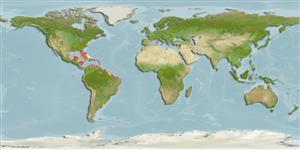>
Carangiformes (Jacks) >
Carangidae (Jacks and pompanos) > Trachinotinae
Etymology: Trachinotus: Greek, trachys, -eia, -ys = rough + Greek,noton = back (Ref. 45335).
Eponymy: Dr George Brown Goode (1851–1896) was an American ichthyologist and museum administrator at the Smithsonian. [...] (Ref. 128868), visit book page.
More on authors: Jordan & Evermann.
Environment: milieu / climate zone / depth range / distribution range
Ekologi
laut berasosiasi dengan karang; kisaran kedalaman 0 - 12 m (Ref. 9710). Subtropical; 43°N - 37°S
Western Atlantic: Massachusetts (USA), Bermuda, and the Gulf of Mexico to Argentina.
Size / Weight / umur
Maturity: Lm ? range ? - ? cm
Max length : 50.0 cm TL jantan/; (Ref. 7251); common length : 35.0 cm TL jantan/; (Ref. 5217); Berat maksimum terpublikasi: 560.00 g (Ref. 40637)
Duri punggung (Keseluruhan (total)) : 7 - 8; duri punggung lunak (Keseluruhan (total)) : 19 - 20; Duri dubur: 2 - 3; Sirip dubur lunak: 16 - 18. Dorsal and anal fins have very long, dark anterior lobes (Ref. 26938). Bluish silver on back, shading to silver on sides, with four narrow dark bars on upper of body (Ref. 13442).
Adults form schools in clear coastal areas, usually near coral formations (Ref. 5217). Juveniles common in clean sandy beaches (Ref. 5217). Adults feed on crustaceans, polychaete worms, insect pupae, mollusks and fishes (Ref. 9626). Between 1995 and 2000, at least 2 specimens were traded as aquarium fish at Fortaleza, Ceará (Ref. 49392).
Life cycle and mating behavior
Kematangan | Reproduksi, perkembang biakan | Pemijahan | telur-telur | Fecundity | Larva
Robins, C.R. and G.C. Ray, 1986. A field guide to Atlantic coast fishes of North America. Houghton Mifflin Company, Boston, U.S.A. 354 p. (Ref. 7251)
Status IUCN Red List (Ref. 130435: Version 2024-1)
ancaman kepada manusia
Reports of ciguatera poisoning (Ref. 30911)
penggunaan manusia
Perikanan: nilai komersial kecil; Budidaya air: komersial; Ikan buruan: ya
Alat, peralatan
laporan khas
muat turun XML
Sumber internet
Estimates based on models
Preferred temperature (Ref.
123201): 23.2 - 28.1, mean 27.3 °C (based on 851 cells).
Phylogenetic diversity index (Ref.
82804): PD
50 = 0.5000 [Uniqueness, from 0.5 = low to 2.0 = high].
Bayesian length-weight: a=0.01698 (0.00970 - 0.02972), b=2.87 (2.72 - 3.02), in cm total length, based on LWR estimates for this species & Genus-body shape (Ref.
93245).
Trophic level (Ref.
69278): 4.3 ±0.4 se; based on diet studies.
Daya lenting (Ref.
120179): sedang, Waktu penggandaan populasi minimum 1.4 - 4.4 tahun (Assuming tm=2-4).
Fishing Vulnerability (Ref.
59153): Moderate vulnerability (40 of 100).
Nutrients (Ref.
124155): Calcium = 39.6 [14.6, 74.0] mg/100g; Iron = 0.785 [0.387, 1.762] mg/100g; Protein = 20.1 [18.1, 22.2] %; Omega3 = 0.158 [0.081, 0.315] g/100g; Selenium = 12 [5, 27] μg/100g; VitaminA = 40.7 [10.2, 151.3] μg/100g; Zinc = 0.509 [0.300, 0.825] mg/100g (wet weight);
